Related Research Articles

The Prince Albert (PA) is one of the most common male genital piercings. The PA is "a ring-style piercing that extends along the underside of the glans from the urethral opening to where the glans meets the shaft of the penis." The related "reverse Prince Albert piercing" enters through the urethra and exits through a hole pierced in the top of the glans.
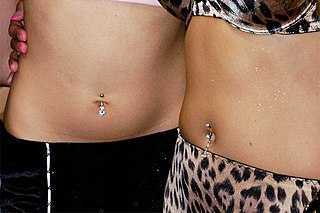
A navel piercing is a type of piercing located through, in, or around, the navel. It may heal quickly and with no irritations, like an ear piercing, or may heal more like a surface piercing with the associated extended healing time. Healing usually takes around 6–9 months, or even more and as long as it is cleaned, it will heal nicely. Unlike most surface piercings, this is one of the few that do not usually reject, although the rejection rate is higher than non-surface piercings, such as ear piercing. A 'true' navel piercing involves piercing the actual navel itself, and is achieved by passing the needle through a protruding outie. However, the term 'navel piercing' more commonly refers to innies, where the skin surrounding the navel is pierced at one or more positions. The most prevalent form of navel piercing is through the upper rim of the navel.

Nose piercing is the piercing of the skin or cartilage which forms any part of the nose, normally for the purpose of wearing jewelry, called a nose-jewel. Among the different varieties of nose piercings, the nostril piercing is the most common.

An earring is a piece of jewelry attached to the ear via a piercing in the earlobe or another external part of the ear. Earrings have been worn by people in different civilizations and historic periods, often with cultural significance.

A tongue piercing is a body piercing usually done directly through the center of the tongue. Since its decline in popularity around 2011, it has seen a recent upsurge making it now the second most popular piercing amongst young women aged 18-25 in 2019. It remains unpopular amongst men. Standard tongue piercings, or one hole in the center of the tongue, is the most common and safest way to have the tongue pierced.

Cheek piercing is facial body piercing through the cheek. The most common variation of the cheek piercing penetrates the facial tissue into the oral cavity. The usual placement is symmetrical on either side of the face, either penetrating or imitating dimples. The piercing can cause the wearer slight nerve damage and will result in "man-made dimples". An alternative is microdermal implants, placed in the intended dimple location. This method avoids drawbacks of full cheek piercings, which have a tendency to leak or secrete lymph fluid, which has a saliva-like texture and can create an unpleasant odor. Though microdermals do have a slightly larger chance to leave a scar than a piercing, they will heal eventually and be almost unnoticeable. The rate of infection is also lower in the long run. Because the piercing does not penetrate the cheek completely, there is little to no chance of tooth or gum damage. Microdermals are like a 'one hole' piercing, where the 'foot' of the jewelry sits below the skin and the decorative jewel or flat disc is above the skin.
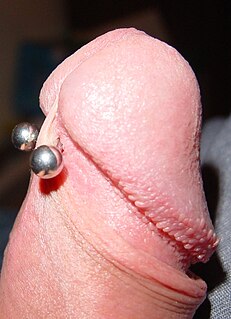
A frenum piercing is a type of body piercing located on the underside of the shaft of the penis. A series of parallel frenum piercings is known as a frenum ladder. A frenum ladder may be extended to include lorum piercings, hafada piercings and guiche piercings.
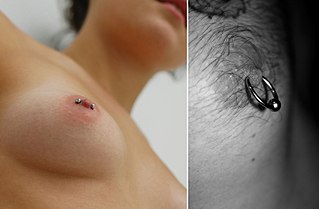
A nipple piercing is a type of body piercing, centered usually at the base of the nipple. It can be pierced at any angle but is usually done horizontally or, less often, vertically. It is also possible to place multiple piercings on top of one another.

James Mark Ward is an American body piercer. In a 2004 documentary, entitled The Social History of Piercing, MTV called him "the granddaddy of the modern body piercing movement."
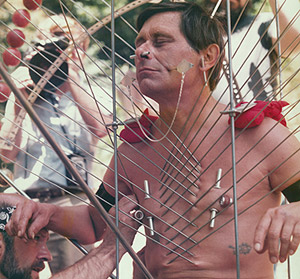
Roland Loomis, known professionally as Fakir Musafar, was an American performance artist considered to be one of the founders of the modern primitive movement.
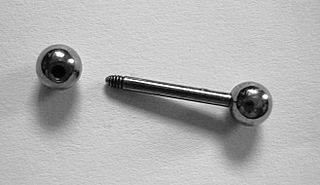
Barbell style piercing jewelry is composed of a straight bar and with a bead on each end, one or both beads unscrewable for removal and/or changing of the beads. Often one of the beads is fixed, either via epoxy or welding, so that only one bead is used to install or remove the jewelry. Barbell threads are usually right-handed.
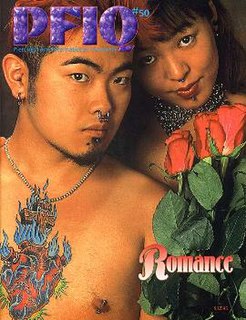
PFIQ was a magazine published by Jim Ward from 1977 to 1997. It was the first publication about body piercing. Ward pioneered the field of body piercing and operated The Gauntlet, which was the first commercial establishment to offer the service in the United States.

A clitoris piercing is a female genital piercing placed directly through the head (glans) of the clitoris itself. It is a relatively uncommon piercing by choice because of the potential for nerve damage, and because women may find it too stimulating to allow the constant wearing of a small ring or barbell. It is often confused with the more common clitoral hood piercing, which pierces only the hood covering the clitoral glans, allowing the jewellery to make only occasional contact with the most sensitive area.
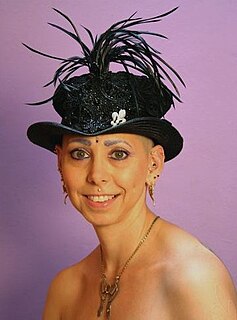
Elayne Angel is an American professional body piercer.

A rook piercing is a perforation of the antihelix of the ear for the purpose of wearing jewelry. It is located just above the tragus on the ridge between the inner and outer conch with the piercing passing from the underside to the top of this ridge, differing from many ear piercings that essentially span between a "front" and "back" surface. Erik Dakota, a well known professional piercer and the individual responsible for originating and popularizing the rook piercing, is said to have named this modification after a shortened version of his first name. The piercing was first named in issue #4 of the magazine Body Play and Modern Primitives Quarterly around 1992 alongside the first printed reference to the industrial piercing, then termed "industrial ear project".
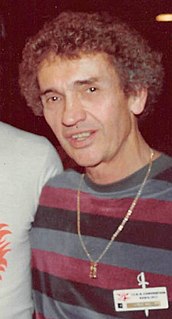
Richard Simonton (1915–1979), also known under the pseudonym Doug Malloy, was a Hollywood businessman and entrepreneur, known for his involvement in the Hollywood community, his rescue of the steamboat Delta Queen, his work in preserving the work of musicians in the Welte-Mignon piano rolls and for founding the American Theatre Organ Society. Among piercing enthusiasts he is also known as an early pioneer of the contemporary resurgence in body piercing.
Alan Oversby was one of the primary figures in the development of contemporary body piercing in Europe. He was better known by his professional name Mr. Sebastian.
A wrist piercing is a piercing through the surface of the wrist, first popularized by Jon Cobb in PFIQ. Wrist piercings are a type of surface piercing. They carry a high rate of rejection and migration, unless they are properly measured and placed. The piercings may be rejected if they are not installed properly; due to the location of the piercings they are easy to irritate, and regularly catch onto clothing or other objects. People with wrist piercings are advised to put on short sleeved t-shirts, singlets so as to prevent the surface barbell from catching onto the threads of the clothing. Also, wrist piercings can only be done with a special tool and thus, it is of high difficulty for it to be home-made. Piercers would also advise that, after getting a wrist piercing, the person is to soak and moisten the wound with mild salted solution so as to disinfect the area, preventing bacteria from entering the unclotted wound. The span of a wrist piercing ranges approximately from as short as 2 weeks to 6 or 7 months.

Body piercing, which is a form of body modification, is the practice of puncturing or cutting a part of the human body, creating an opening in which jewelry may be worn, or where an implant could be inserted. The word piercing can refer to the act or practice of body piercing, or to an opening in the body created by this act or practice. It can also, by metonymy, refer to the resulting decoration, or to the decorative jewelry used. Piercing implants alter body and/or skin profile and appearance. Although the history of body piercing is obscured by popular misinformation and by a lack of scholarly reference, ample evidence exists to document that it has been practiced in various forms by multiple sexes since ancient times throughout the world.

Horst Streckenbach “Tattoo Samy” was a well-known German tattoo artist and historian of the medium, who had been tattooing since 1946. Streckenbach is considered important in the development of tattooing in Germany. With Manfred Kohrs from Hanover in Germany from 1974 to 1978 he developed a rotary tattoo machine and in 1975 the barbell.
References
- 1 2 Brandon Voss (2007-10-09). "Father Knows Best". The Advocate . Retrieved 2007-11-25.
- ↑ "Running the Gauntlet" Archived 2012-07-09 at archive.today , cited in "In the Flesh: Body Piercing as a Form of Commodity-Based Identity and Ritual Rite of Passage," honors thesis by Amelia Guimarin, under the direction of Prof. Teresa Caldiera, Anthropology, UC Irvine, 2005
- ↑ Ferguson, Henry (January 2000). "Body piercing". Student BMJ . Retrieved 2007-11-25.
- ↑ 🖉 "Pantheon of Leather Awards All Time Recipients - The Leather Journal". www.theleatherjournal.com. Archived from the original on 2020-12-28. Retrieved 2020-12-27.